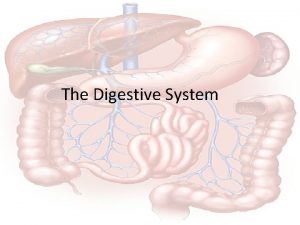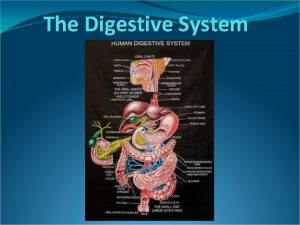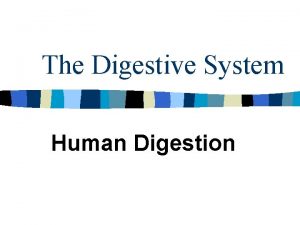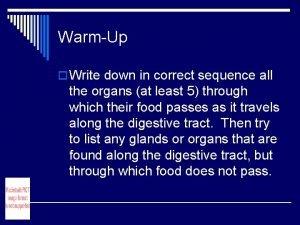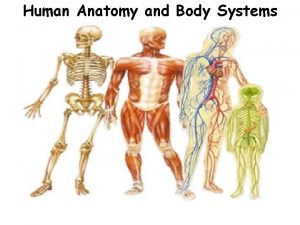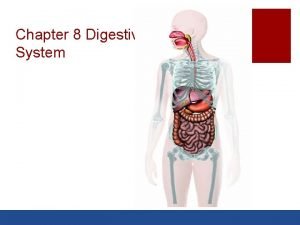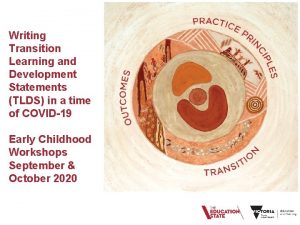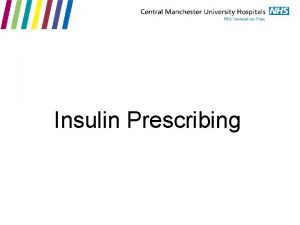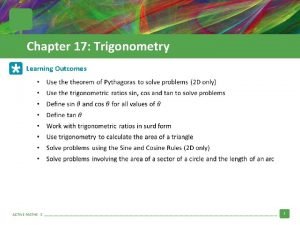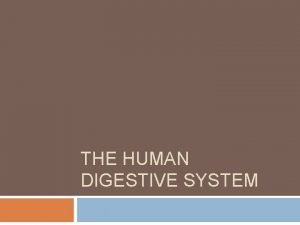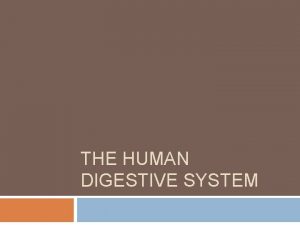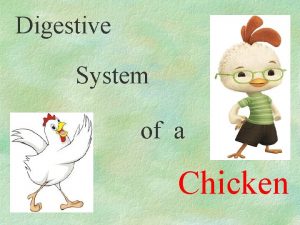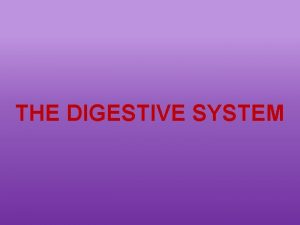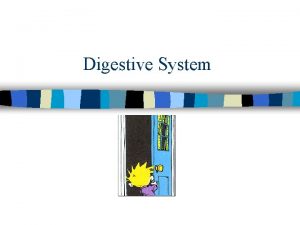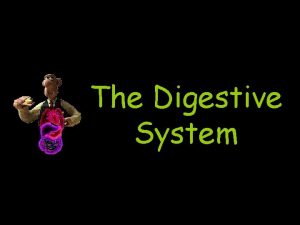2 3 HUMAN DIGESTIVE SYSTEM Learning outcome explain



















- Slides: 19

2. 3 HUMAN DIGESTIVE SYSTEM

Learning outcome • explain what digestion is. • identify the parts of the digestive system. • describe the flow of food particles in the alimentary canal. • state the functions of the organs in the digestive system. • describe the process of digestion in the alimentary canal. • list the end products of digestion of carbohydrate, protein and fats.

Digestion • Process of breaking down complex food to simple molecule for absorption into the blood circulatory system.

• 2 stages: – Physical digestion – big pieces of food are broken down into smaller pieces by teeth – Chemical digestion – enzymes break up complex food molecules into smaller molecules.

Enzyme • What is enzyme? ? – Protein that speed up the process of digestion. • Characteristic of enzymes – – required in small quantities Not destroyed at the end of digestion Act only specific foods Function best at normal body temperature (37 celcius). It destroyed at high temperature. – Specific enzyme act only in specific acidic or alkaline conditions.

Digestive system • What must you know? ? • Organ that involve in digestive system. . – Mouth, oesophagus, stomach, pancreas, bile duct, gall bladder, liver, small intestine, large intestine, anus • Alimentary canal start from mouth, oesophagus, stomach, small intestine, large intestine and the end at anus. • Process of peristalsis – food that pushed along the alimentary canal by contract and relax of muscular walls


Mouth (physical digestion) • Food chewed and broken up into small pieces by the teeth. • Small pieces of food have wide surface are for the saliva to act upon. • The salivary gland secrets saliva that is alkaline and contains salivary amylase • Salivary amylase convert starch into maltose Salivary amylase Starch maltose

Oesophagus • No digestion take place. Why? ? ? • Food from mouth pushed through oesophagus(gullet) into the stomach by the alternating muscular contraction and relaxation of the oesophagus • Process peristalsis.

Stomach • Food mixed with gastric juice • What is gastric juice? ? ? – Juice that secreted from the cell at stomach wall. – Contain Hydrochloric acid and enzyme rennin and pepsin

Hydrochloric acid • Function of hydrochloric acid – Providing and acidic medium for enzymic action – Killing bacteria found in food – Neutralising the alkaline property of saliva and stopping the action of salivary amylase

Cont… • Pepsin – Digest protein into peptones Pepsin Protein Peptone • Rennin – Coagulates milk in the stomach to help in the enzymic action of pepsin Rennin Liquid milk protein Solid milk protein

Small intestine • The duodenum is first part of the small intestine – Receive bile and pancreatic juices

Bile • Bile produced by liver and stored in the gall bladder. • Bile flows from gall bladder into the duodenum through the bile duct. • Function of bile: – Emulsification of fat – Preparation of an alkaline medium for enzymic action

Pancreatic juice • Produced by pancreas cell • Contain 3 type of enzyme – Pancreatic amylase(digest starch) Pancreatic amylase • Starch maltose – Protease( digest peptones) • Peptones Protease amino acods – Lipase lipase • Fat fatty acids+ glycerol

• Small intestine also produce enzyme maltase that digest maltose into glucose • Digestion is completed in the small intestine • It ready to be absorbed into the blood stream through the thin wall of the small intestine

Large intestine • Absorb water • Undigested food is expelled from the body through the anus as faeces

End products of digestion • The end product must in simple forms that readily absorbed into the small intestine through villi Class of food Final product of digestion Carbohydrate Glucose amylase maltase Starch maltose glucose Protein Amino acid pepsin protease Protein peptones amino acid Fatty acid and glycerol bile lipase Large fatty globules small droplet fatty acid and glycerol

The end
 Respiratory system circulatory system digestive system
Respiratory system circulatory system digestive system Human digestive system facts
Human digestive system facts Human digestive system facts
Human digestive system facts Introduction on digestive system
Introduction on digestive system Introduction about digestive system
Introduction about digestive system Human digestive system in order
Human digestive system in order Write the correct sequence of human digestive system
Write the correct sequence of human digestive system Human digestive system images
Human digestive system images Digestive system labelling
Digestive system labelling Learning outcomes of digestive system
Learning outcomes of digestive system Learning outcomes generator
Learning outcomes generator Poetry learning objectives
Poetry learning objectives Transition learning and development statement examples
Transition learning and development statement examples Learning outcomes prescribe
Learning outcomes prescribe Learning outcomes of trigonometry
Learning outcomes of trigonometry Example of learning outcomes
Example of learning outcomes Examples of educational goals and objectives
Examples of educational goals and objectives Nervous system and digestive system
Nervous system and digestive system Cuadro comparativo e-learning y b-learning
Cuadro comparativo e-learning y b-learning Alternative learning system learning strands
Alternative learning system learning strands

